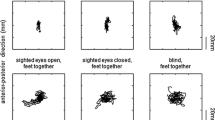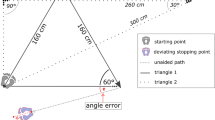Abstract
Good balance, an important ability in controlling body movement, declines with age. Also, balance appears to decrease when visual input is restricted, while this has been poorly investigated among visually impaired very old adults. The objective of this study is thus to explore whether the balance control of the very old differs with varying degrees of visual impairment. This cross-sectional study was conducted in community centers and residential care homes. Thirty-three visually impaired (17 = low vision; 16 = blind) and 15 sighted elderly aged ≥70 years participated in the study. All participants were assessed: (1) concentric isokinetic strength of the knee extensors and flexors; (2) a sensory organization test to measure their ability to use somatosensory, visual, and vestibular information to control standing balance; (3) a perturbed double-leg stance test to assess the ability of the automatic motor system to quickly recover following an unexpected external disturbance; (4) the five times sit-to-stand test. Compared with low-vision subjects, the sighted elderly achieved higher peak torque-to-body weight ratios in concentric knee extension. The sighted elderly showed less body sway than the low vision and blind subjects in sensory conditions where they benefited from visual inputs to help them maintain standing balance. The sighted and low-vision subjects achieved smaller average body sway angles during forward and backward platform translations compared to the blind subjects. Low vision and blindness decrease balance control in elderly.


Similar content being viewed by others
References
Baloh RW, Jacobson KM, Socotch TM (1993) The effect of aging on visual-vestibuloocular responses. Exp Brain Res 95(3):509–516
Chen EW, Fu ASN, Tsang WWN (2010) Tai Chi training improves balance control in subjects with visual impairment. Abstract for the Seventh Pan-Pacific Conference on Rehabilitation. Hong Kong, p 48
Congdon N, O’Colmain B, Klaver CCW et al (2004) Causes and prevalence of visual impairment among adults in the United States. Arch Ophthalmol 122(4):477–485
Crews JE, Campbell VA (2001) Health conditions, activity limitations, and participation restrictions among older people with visual impairments. J Vis Impair Blind 95(8):453–467
Di Girolamo S, Di Nardo W, Cosenza A, Ottaviani F, Dickmann A, Savino G (1999) The role of vision on postural strategy evaluated in patients affected by congenital nystagmus as an experimental model. J Vestib Res 9(6):445–451
Elliott DB, Patla AE, Flanagan JG et al (1995) The Waterloo vision and mobility study: postural control strategies in subjects with ARM. Ophthal Physiol Opt 15(6):553–559
Enrietto JA, Jacobson KM, Baloh RW (1999) Aging effects on auditory and vestibular responses: a longitudinal study. Am J Otolaryngol 20(6):371–378
Fitzpatrick R, McCloskey DI (1994) Proprioceptive, visual and vestibular thresholds for the perception of sway during standing in humans. J Physiol 478(1):173–186
Folstein MF, Folstein WE, McHugh PR (1975) “Mini-Mental State” a practical method for grading the cognitive state of patients for the clinician. J Psychiatr Res 12(3):189–198
Held R (1970) Two modes of processing spatially distributed visual stimulation. In: Schmitt FO (ed) The neurosciences: second study program. Rockefeller University Press, New York, pp 317–323
Hong Kong Blind Union (2001) Epidemiology of visual impairment in Hong Kong. http://www.hkbu.org.hk/42.0.html
Lee HKM, Scudds RJ (2003) Comparison of balance in older people with and without visual impairment. Age Ageing 32(6):643–649
Lord SR, Menz HB (2000) Visual contributions to postural stability in older adults. Gerontology 46(6):306–310
Mong Y, Teo TWL, Ng SSM (2010) 5-repetition sit-to-stand test in subjects with chronic stroke: reliability and validity. Arch Phys Med Rehabil 91(3):407–413
NeuroCom (2000) Smart EquiTest system operators manual (version 7.04). NeuroCom International Inc., Clackamas, pp PO 6–7, LOS 5–7
Skinner HB, Barrack RL, Cook SD (1984) Age-related decline in proprioception. Clin Orthop Relat Res 184:208–211
Stones MJ, Kozma A (1987) Balance and age in the sighted and blind. Arch Phys Med Rehabil 68(2):85–89
Sturnieks DL, St George R, Lord SR (2008) Balance disorders in the elderly. Neurophysiol Clin 38(6):467–478
Tsang WWN, Hui-Chan CWY (2003) Effects of Tai Chi on joint proprioception and stability limits in elderly subjects. Med Sci Sports Exerc 35(12):1962–1971
Tsang WWN, Hui-Chan CWY (2004) Effects of exercise on joint sense and balance in elderly men: Tai chi versus golf. Med Sci Sports Exerc 36(4):658–667
Tsang WWN, Hui-Chan CWY (2005) Comparison of muscle torque, balance, and confidence in older tai chi and healthy adults. Med Sci Sports Exerc 37(2):280–289
Tsang WW, Wong VS, Fu SN, Hui-Chan CW (2004) Tai chi improves standing balance control under reduced or conflicting sensory conditions. Arch Phys Med Rehabil 85(1):129–137
Van Heuvelen MJ, Kempen GI, Ormel J, Rispens P (1998) Physical fitness related to age and physical activity in older persons. Med Sci Sports Exerc 30(3):434–441
Wallmann HW (2001) Comparison of elderly nonfallers and fallers on performance measures of functional reach, sensory organization, and limits of stability. J Gerontol A Bio Sci Med Sci 56(9):M580–M583
Whitney SL, Wrisley DM, Marchetti GF, Gee MA, Redfern MS, Furman JM (2005) Clinical measurement of sit-to-stand performance in people with balance disorders: validity of data for the five-times-sit-to-stand test. Phys Ther 85(10):1034–1045
World Health Organization (2007) International statistical classification of disease and related health problems, 10th revision. Chapter VII. H54. Blindness and low vision. http://www.who.int/classifications/icd/en/
Acknowledgments
The authors thank the S.K. Yee Medical Foundation and the Hong Kong Polytechnic University for financial support of this study. Thanks are also owed to the subjects and to the older adult centers for permission to recruit their members. The authors also thank Mr. Bill Purves for his English editorial advice. No commercial party having a direct financial interest in the research findings reported here has conferred or will confer a benefit on the authors or on any organization with which the authors are associated.
Author information
Authors and Affiliations
Corresponding author
Additional information
Communicated by Dick F. Stegeman.
Rights and permissions
About this article
Cite this article
Chen, E.W., Fu, A.S.N., Chan, K.M. et al. Balance control in very old adults with and without visual impairment. Eur J Appl Physiol 112, 1631–1636 (2012). https://doi.org/10.1007/s00421-011-2139-1
Received:
Accepted:
Published:
Issue Date:
DOI: https://doi.org/10.1007/s00421-011-2139-1




